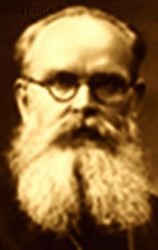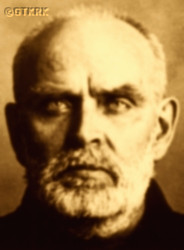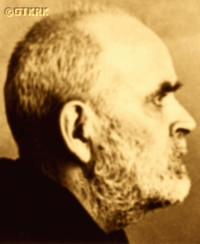Roman Catholic
St Sigismund parish
05-507 Słomczyn
85 Wiślana Str.
Konstancin deanery
Warsaw archdiocese, Poland
full list:
displayClick to display full list

searchClick to search full list by categories
wyświetlKliknij by wyświetlić pełną listę po polsku

szukajKliknij by przeszukać listę wg kategorii po polsku

Martyrology of the clergy — Poland
XX century (1914 – 1989)
personal data
religious status
Servant of God
surname
ABRANTOWICZ
forename(s)
Fabian
function
religious cleric
creed
Byzantine–Slavic Catholic Church BSmore on
pl.wikipedia.org
[access: 2013.01.13]
Latin (Roman Catholic) Church RCmore on
en.wikipedia.org
[access: 2014.09.21]
congregation
Congregation of Marian Fathers of the Immaculate Conception of the Most Blessed Virgin Mary MICmore on
en.wikipedia.org
[access: 2013.05.19]
(i.e. Marians of the Immaculate Conception)
diocese / province
Apostolic BS Exarchate of Harbin (Russia)more on
www.catholic-hierarchy.org
[access: 2022.12.04]
Pinsk diocesemore on
en.wikipedia.org
[access: 2013.05.19]
Minsk diocesemore on
en.wikipedia.org
[access: 2013.05.19]
Mogilev archdiocesemore on
en.wikipedia.org
[access: 2013.06.23]
academic distinctions
Doctor of Philosophy
Sacred Theology MA
honorary titles
prelate‐scholaster (Lat. praelati‐scholasticus)more on
prelate—scholaster (Lat. praelati—scholasticus)
(Holy Name of Blessed Virgin Mary RC cathedral church, Minsktoday: Minsk city reg., Belarus
more on
en.wikipedia.org
[access: 2020.07.31])
nationality
Belarusian
date and place
of death
02.01.1946

Moscowtoday: Moscow city, Russia
more on
en.wikipedia.org
[access: 2020.07.31]
details of death
After Ryga accord ending Polish–Russian war of 1919‐1920 found himself in Poland, though still belonging to Minsk diocese.
After access to the Congregation of Marian Fathers ministered in Manchuria.
In 08.1939 visited Poland — after ad‐limina visit in Rome — and there, in Novohrudok, found him the outbreak of the World War II started by German and Russian invasion of Poland in 09.1939.
After start of Russian occupation, went in 10.1939 to Lviv to visit Greek Catholic Abp Szeptycki.
On 21.10,1939, illegally crossed the new border between the Russian and German occupiers of Poland near Uhniv without Russian or German „permission”, but was intercepted by the Germans.
On 22.10.1939 handed over back to the Russians, and promptly arrested.
Held first prob. in Rava‐Ruska, and then transported to Lviv.
Jailed n Zamarstynów prison in Lviv.
There repeatedly interrogated and tortured.
Accused of spying for Japan, among others.
Admitted that „all his activity consisted in fighting communism and Soviet Russia by word and print”.
In 01.1941 moved to Moscow, to Butyrki prison.
Interrogated and tortured in Lubyanka NKVD headquarters.
At the end of the investigation, it was recorded that the accused „does not feel guilty”.
On 23.09.1942 sentenced to 10 years of slave labour in Russian concentration camp — Gulag — in Karaganda.
Prob. due to an illness never left Moscow.
Tortured to death in Butyrki prison.
cause of death
murder
perpetrators
Russians
sites and events
Moscow (Butyrki)Click to display the description, ITL KarLagClick to display the description, Moscow (Lubyanka)Click to display the description, Lviv (Zamarstiniv)Click to display the description, Ribbentrop‐MolotovClick to display the description, Pius XI's encyclicalsClick to display the description, Polish‐Russian war of 1919‐1921Click to display the description
date and place
of birth
14.09.1884

Vereskovshczhinagrange
today: non‐existent, Lubcha ssov., Navahrudak dist., Grodno reg., Belarus
more on
be.wikipedia.org
[access: 2023.01.18]
alt. dates and places
of birth
14.11.1884
parents
ABRANTOWICZ John
🞲 ?, ? — 🕆 ?, ?

🞲 ?, ? — 🕆 ?, ?
religious vows
03.08.1927 (temporary)
03.08.1930 (permanent)
presbyter (holy orders)
ordination
09.11.1908

positions held
1928 – 1939
Apostolic Exarch i.e. Archimandrite — Harbintoday: Heilongjiang prov., China
more on
en.wikipedia.org
[access: 2024.03.19] ⋄ Apostolic Exarchate of Harbin of the Catholic Byzantine–Slavic (Russian) rite — appointment: on 31.05.1928
1927 – 1928
friar — Druyatoday: Druya ssov., Braslaw dist., Vitebsk reg., Belarus
more on
en.wikipedia.org
[access: 2021.09.29] ⋄ Congregation's house, Marians of the Immaculate Conception MIC
08.1926 – 03.08.1927
novitiate — Druyatoday: Druya ssov., Braslaw dist., Vitebsk reg., Belarus
more on
en.wikipedia.org
[access: 2021.09.29] ⋄ Congregation's house, Marians of the Immaculate Conception MIC
15.06.1926
accession — Marians of the Immaculate Conception MIC
1925 – 1926
professor — Pinsktoday: Pinsk city dist., Brest reg., Belarus
more on
en.wikipedia.org
[access: 2022.07.16] ⋄ St Thomas Aquinas' Theological Seminary — prob. lecturer in philosophy; also: spiritual father and treasury officer / procurator of the seminary
1924 – 1925
vicar general — Minsk (its part in Poland) RC diocese
c. 1925
prelate‐scholaster (Lat. praelati‐scholasticus) — Minsktoday: Minsk city reg., Belarus
more on
en.wikipedia.org
[access: 2020.07.31] ⋄ Cathedral Chapter ⋄ Name of the Blessed Virgin Mary RC cathedral church ⋄ Minsk RC diocese
1921 – 1924
teacher — Navahrudaktoday: Navahrudak dist., Grodno reg., Belarus
more on
en.wikipedia.org
[access: 2021.07.04] ⋄ Minsk diocese Minor Theological Seminary — also: judge of the church tribunal of the diocese of Minsk (in practice its part within the borders of Poland), post‐synodal examiner, censor of religious books, member of the administrative board of the diocese and the supervisory board of the seminary
1920 – 1921
vicar — Navahrudaktoday: Navahrudak dist., Grodno reg., Belarus
more on
en.wikipedia.org
[access: 2021.07.04] ⋄ St Michael the Archangel RC parish ⋄ Navahrudaktoday: Navahrudak dist., Grodno reg., Belarus
more on
en.wikipedia.org
[access: 2021.07.04] RC deanery — prefect at the gymnasium, organizer of education
04.1918 – 1920
rector — Minsktoday: Minsk city reg., Belarus
more on
en.wikipedia.org
[access: 2020.07.31] ⋄ Theological Seminary — seminary for newly established Minsk dioceses was opened after the Treaty of Brest–Litovsk in 03.1918 between Bolshevik Russia and Germany (later on 09‐10.07.1920, during the Polish–Russian war, the seminary was evacuated to Włocławek, and in 1921 it temporarily moved to Kielce)
1914 – 1918
professor — Sankt Petersburgtoday: Saint Petersburg city, Russia
more on
en.wikipedia.org
[access: 2020.07.31] ⋄ Metropolitan Theological Seminary — lecturer in philosophy, Catholic social teaching and singing; also: teacher of law at the Girls' Gymnasium of the Imperial Women's Institute, and canon law teacher at Gymnasium No. 12
1912 – 1914
PhD student — Louvaintoday: Flemish Brabant prov., Flemish reg., Belgium
more on
en.wikipedia.org
[access: 2020.11.07] ⋄ philosophy, Université Catholique de Louvain (pl. Catholic University of Leuven) — PhD thesis Fr. „Les Concepts philosophiques de la conception du monde de Nicolas Lossky” (Eng. „The Philosophical Concepts of the Conception of the World by Nicolas Lossky”)
1910 – 1912
resident — Sankt Petersburgtoday: Saint Petersburg city, Russia
more on
en.wikipedia.org
[access: 2020.07.31] ⋄ St Catherine of Alexandria the Virgin and Martyr RC parish ⋄ Sankt Petersburgtoday: Saint Petersburg city, Russia
more on
en.wikipedia.org
[access: 2020.07.31] RC deanery — prefect and teacher of canon law at the Men's Gymnasium at the parish and lecturer of canon law at the Imperial School of Jurisprudence; also true. law teacher at the Imperial Commercial School, Tsar Alexander II's Cadet Corps School, Mariinsky and Pavlovsky Institutes for women
1906 – 1910
student — Sankt Petersburgtoday: Saint Petersburg city, Russia
more on
en.wikipedia.org
[access: 2020.07.31] ⋄ theology, Imperial Roman Catholic Spiritual Academy (1842‐1918) — postgraduate specialised studies crowned with a Sacred Theology Master's degree
1900 – 1906
student — Sankt Petersburgtoday: Saint Petersburg city, Russia
more on
en.wikipedia.org
[access: 2020.07.31] ⋄ philosophy and theology, Metropolitan Theological Seminary
sites and events
descriptions
Moscow (Butyrki): Harsh transit and interrogation prison in Moscow — for political prisoners — where Russians held and murdered thousands of Poles. Founded prob. in XVII century. In XIX century many Polish insurgents (Polish uprisings of 1831 and 1863) were held there. During Communist regime a place of internment for political prisoners prior to a transfer to Russian slave labour complex Gulag. During the Great Purge c. 20,000 inmates were held there at any time (c. 170 in every cell). Thousands were murdered. (more on: en.wikipedia.orgClick to attempt to display webpage
[access: 2020.05.01])
ITL KarLag: Russian Rus. Исправи́тельно‐Трудово́й Ла́герь (Eng. Corrective Labor Camp) ITL Rus. Карагандинский (Eng. Karagandskiy) — concentration and slave forced labor camp (within the Gulag complex) — with headquarters in the city of Karaganda, Karaganda Oblast in Kazakhstan. Founded on 17.09.1931. One of the largest in the Gulag complex. It covered an area of 300 by 200 km, with its center in the Dolynka village, c. 45 km from Karaganda. One of the tasks was to grow food, especially animal husbandry, for the emerging centers of coal mining and heavy industry in Kazakhstan. Prisoners slaved in camp workshops (metal processing, drawing, tailoring), in the production of construction materials, in a glassworks, a sugar refinery, a vegetable drying plant, in coal mines, limestone mining, and in fishing. At its peak, c. 65,000 prisoners were held there: e.g. 45,798 (01.01.1943); 50,080 (01.01.1944); 53,946 (01.01.1945); 60,745 (01.01.1947); 63,555 (01.01.1948); 65,673 (01.01.1949); 54,179 (01.01.1950); 45,675 (01.01.1951). In total, c. 1,000,000 people passed through the camp, including many women and children. Many died. It ceased operations on 27.07.1959. (more on: en.wikipedia.orgClick to attempt to display webpage
[access: 2019.10.13])
Moscow (Lubyanka): Location of a murderous Russian Cheka and next GPU and NKVD (later MVD and KGB) organisations and a prison (in the basement, with 118 cells — in 1936 — of which 94 were solitary — altogether at any time up to 350 prisoners were held there and c. 2,857 in 1937) in Moscow at Lubyanka Square where Russians interrogated and murdered many political prisoners. Most of the prisoners after investigations were transferred to other Moscov prisons, e.g. Butyrki. (more on: en.wikipedia.orgClick to attempt to display webpage
[access: 2014.10.31])
Lviv (Zamarstiniv): Penal prison no 2 in Lviv. In 1939‐1941 Russians organised there an NKVD detention centre and jailed thousands of prisoners, mainly Poles and Ukrainians, interrogating them and torturing. In 06.1941 after German invasion Russians murdered few thousands of them in a mass massacre. (more on: pl.wikipedia.orgClick to attempt to display webpage
[access: 2015.09.30])
Ribbentrop‐Molotov: Genocidal Russian‐German alliance pact between Russian leader Joseph Stalin and German leader Adolf Hitler signed on 23.08.1939 in Moscow by respective foreign ministers, Mr. Vyacheslav Molotov for Russia and Joachim von Ribbentrop for Germany. The pact sanctioned and was the direct cause of joint Russian and German invasion of Poland and the outbreak of the World War II in 09.1939. In a political sense, the pact was an attempt to restore the status quo ante before 1914, with one exception, namely the „commercial” exchange of the so‐called „Kingdom of Poland”, which in 1914 was part of the Russian Empire, fore Eastern Galicia (today's western Ukraine), in 1914 belonging to the Austro‐Hungarian Empire. Galicia, including Lviv, was to be taken over by the Russians, the „Kingdom of Poland” — under the name of the General Governorate — Germany. The resultant „war was one of the greatest calamities and dramas of humanity in history, for two atheistic and anti‐Christian ideologies — national and international socialism — rejected God and His fifth Decalogue commandment: Thou shall not kill!” (Abp Stanislav Gądecki, 01.09.2019). The decisions taken — backed up by the betrayal of the formal allies of Poland, France and Germany, which on 12.09.1939, at a joint conference in Abbeville, decided not to provide aid to attacked Poland and not to take military action against Germany (a clear breach of treaty obligations with Poland) — were on 28.09.1939 slightly altered and made more precise when a treaty on „German‐Russian boundaries and friendship” was agreed by the same murderous signatories. One of its findings was establishment of spheres of influence in Central and Eastern Europe and in consequence IV partition of Poland. In one of its secret annexes agreed, that: „the Signatories will not tolerate on its respective territories any Polish propaganda that affects the territory of the other Side. On their respective territories they will suppress all such propaganda and inform each other of the measures taken to accomplish it”. The agreements resulted in a series of meeting between two genocidal organization representing both sides — German Gestapo and Russian NKVD when coordination of efforts to exterminate Polish intelligentsia and Polish leading classes (in Germany called «Intelligenzaktion», in Russia took the form of Katyń massacres) where discussed. Resulted in deaths of hundreds of thousands of Polish intelligentsia, including thousands of priests presented here, and tens of millions of ordinary people,. The results of this Russian‐German pact lasted till 1989 and are still in evidence even today. (more on: en.wikipedia.orgClick to attempt to display webpage
[access: 2015.09.30])
Pius XI's encyclicals: Facing the creation of two totalitarian systems in Europe, which seemed to compete with each other, though there were more similarities than contradictions between them, Pope Pius XI issued in 03.1937 (within 5 days) two encyclicals. In the „Mit brennender Sorge” (Eng. „With Burning Concern”) published on 14.03.1938, condemned the national socialism prevailing in Germany. The Pope wrote: „Whoever, following the old Germanic‐pre‐Christian beliefs, puts various impersonal fate in the place of a personal God, denies the wisdom of God and Providence […], whoever exalts earthly values: race or nation, or state, or state system, representatives of state power or other fundamental values of human society, […] and makes them the highest standard of all values, including religious ones, and idolizes them, this one […] is far from true faith in God and from a worldview corresponding to such faith”. On 19.03.1937, published „Divini Redemptoris” (Eng. „Divine Redeemer”), in which criticized Russian communism, dialectical materialism and the class struggle theory. The Pope wrote: „Communism deprives man of freedom, and therefore the spiritual basis of all life norms. It deprives the human person of all his dignity and any moral support with which he could resist the onslaught of blind passions […] This is the new gospel that Bolshevik and godless communism preaches as a message of salvation and redemption of humanity”… Pius XI demanded that the established human law be subjected to the natural law of God , recommended the implementation of the ideal of a Christian state and society, and called on Catholics to resist. Two years later, National Socialist Germany and Communist Russia came together and started World War II. (more on: www.vatican.vaClick to attempt to display webpage
[access: 2023.05.28], www.vatican.vaClick to attempt to display webpage
[access: 2023.05.28])
Polish‐Russian war of 1919‐1921: War for independence of Poland and its borders. Poland regained independence in 1918 but had to fight for its borders with former imperial powers, in particular Russia. Russia planned to incite Bolshevik‐like revolutions in the Western Europe and thus invaded Poland. Russian invaders were defeated in 08.1920 in a battle called Warsaw battle („Vistula river miracle”, one of the 10 most important battles in history, according to some historians). Thanks to this victory Poland recaptured part of the lands lost during partitions of Poland in XVIII century, and Europe was saved from the genocidal Communism. (more on: en.wikipedia.orgClick to attempt to display webpage
[access: 2014.12.20])
sources
bibliographical:
„Lexicon of Polish clergy repressed in USSR in 1939‐1988”, Roman Dzwonkowski, SAC, ed. Science Society KUL, 2003, Lublin
„Pinsk Diocese in Poland Clergy and Church Register”, Pinsk diocese bishop, 1933‐1939, diocesan printing house
original images:
padrimariani.orgClick to attempt to display webpage
[access: 2013.06.23], www.memo.ruClick to attempt to display webpage
[access: 2016.03.14], www.memo.ruClick to attempt to display webpage
[access: 2016.03.14], ipn.gov.plClick to attempt to display webpage
[access: 2019.02.02]
LETTER to CUSTODIAN/ADMINISTRATOR
If you have an Email client on your communicator/computer — such as Mozilla Thunderbird, Windows Mail or Microsoft Outlook, described at WikipediaPatrz:
en.wikipedia.org, among others — try the link below, please:
LETTER to CUSTODIAN/ADMINISTRATORClick and try to call your own Email client
If however you do not run such a client or the above link is not active please send an email to the Custodian/Administrator using your account — in your customary email/correspondence engine — at the following address:

giving the following as the subject:
MARTYROLOGY: ABRANTOWICZ Fabian
To return to the biography press below:
 Click to return to biography
Click to return to biography











